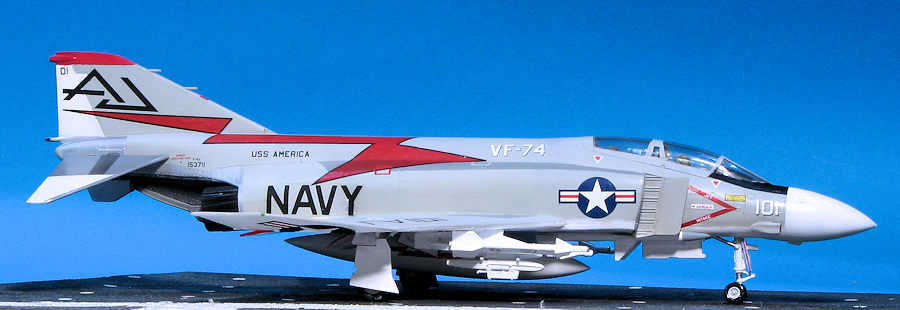
| KIT #: | 5440 |
| PRICE: | $ |
| DECALS: | One option |
| REVIEWER: | Scott Van Aken |
| NOTES: | Released in 1985 |

| HISTORY |
As most people who like jets know, the McDonnell F-4 Phantom II was developed to be a fleet defense fighter to replace the F-8 Crusader. In a flyoff between the XF8U-3 and the XF4H-1, the XF4H-1 (later F-4A) 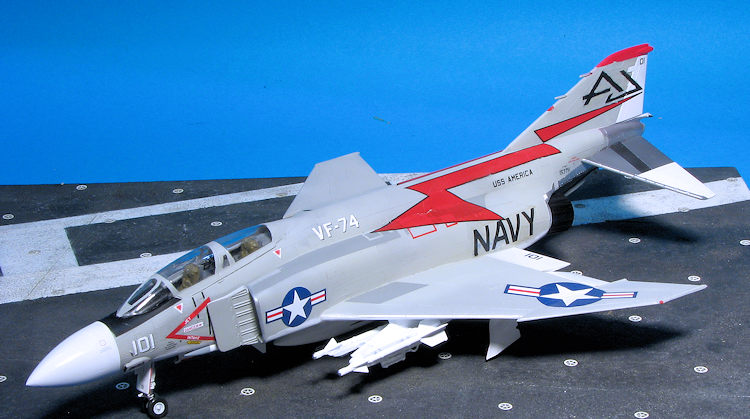 was the winner as much due to its two man cockpit and two engines (something useful when flying over large expanses of water) as anything.
was the winner as much due to its two man cockpit and two engines (something useful when flying over large expanses of water) as anything.
The prototype flew in 1958 and the first deliveries to the USN were in 1961. The aircraft was a world beater and broke numerous speed and altitude records. It has been said that the aircraft runs out of fuel before it stops accelerating. Probably apocryphal, but it makes a good story. Thanks to the troubling TFX/F-111 program, the USAF bought into the aircraft to replace the F-105, and ended up flying more than twice the number of F-4s as the Navy. Aside from drones, the plane was retired from US service in the 1990s. The type was sold and manufactured overseas with some air forces still flying the aircraft nearly 60 years after it first took to the air.
There is, of course, much more to the plane's history than this, but it is enough to get one who knows little about the plane started.
| THE KIT |
I would say that Monogram's two Phantom kits in this scale were, until the Hasegawa kits of the 1990s, the best F-4 kits on the market in this scale. The kit was pantographed down from the larger 1/48 version so has many of the same qualities and goofs as the big brother.
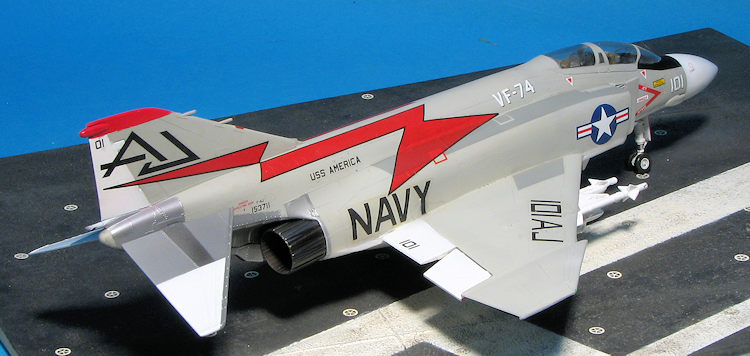 First of all, there are no real options aside from open canopies and the ability to install intake RHAW receiver antennas on the intakes. The detailing is excellent though it is of the raised panel line variety. It had and perhaps still has the best cockpit of any 1/72 F-4 kit. Since this is the naval version, it includes the large circuit breaker panel on the right of the back seater's cockpit. The left side is unchanged from the USAF version as is the rest of the rear cockpit. Navy F-4s almost always had no rear controls. It was possible to install them and several were so done in training squadrons, but normally the GIB (guy in back) was not a pilot.
First of all, there are no real options aside from open canopies and the ability to install intake RHAW receiver antennas on the intakes. The detailing is excellent though it is of the raised panel line variety. It had and perhaps still has the best cockpit of any 1/72 F-4 kit. Since this is the naval version, it includes the large circuit breaker panel on the right of the back seater's cockpit. The left side is unchanged from the USAF version as is the rest of the rear cockpit. Navy F-4s almost always had no rear controls. It was possible to install them and several were so done in training squadrons, but normally the GIB (guy in back) was not a pilot.
The flaps were normally slightly drooped when the plane was on the ground and so it is with this one. The kit comes with slatted rear stabilizers, which is correct for the F-4J. Those stabilizers, however, have a piece near the fuselage which makes them proud of the fuselage. Normally they are very close and it wasn't unusual to see scrapes on the fuselage where the stabs flexed and scored the paint or metal. Another oddity is on the Sidewinder missiles. It has some sort of 'thing' forward of the front fins that I've never seen on any photo. Not sure what it is, but Monogram dutifully included it on both their 1/72 and 1/48 Phantoms.
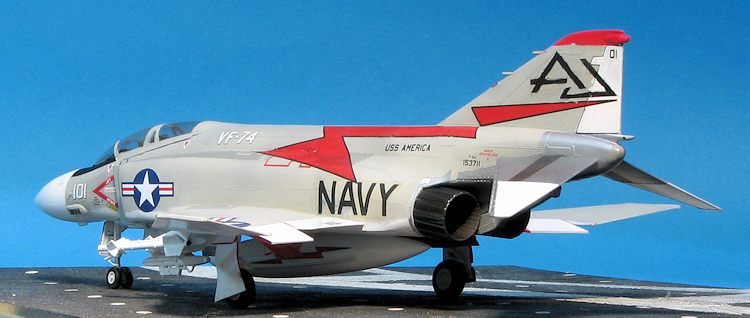 Landing gear is well done and while there is no gear up options shown, one can do so with a bit of work. Other things under the airframe are a pair of wing tanks, a centerline tank, four Sparrows, and six Mk 82 bombs with fuse extenders. All of the holes for the various pylons and tanks are already opened on the lower wing. Also opened are the sockets for the alignment pins near the flaps so you'll have to fill those.
Landing gear is well done and while there is no gear up options shown, one can do so with a bit of work. Other things under the airframe are a pair of wing tanks, a centerline tank, four Sparrows, and six Mk 82 bombs with fuse extenders. All of the holes for the various pylons and tanks are already opened on the lower wing. Also opened are the sockets for the alignment pins near the flaps so you'll have to fill those.
Instructions are well drawn with generic and FS 595 color references. The lone marking option is for the box art plane from VF-92 in matte light gull grey over gloss white, with gloss white flight control surfaces. One does have to paint the yellow part of the fin, the area on the upper nose as well as the wing and intake walk areas.The cockpit surround markings are provided. Decals are nicely printed and are very glossy as well as being a bit thick.
| CONSTRUCTION |
It has been decades since I built one of these, but I have built several and pretty well know where the areas of concern might be. First step was to paint the cockpit tub and interior sidewalls with dark gull grey. While looking for the control stick for the front seat, I realized it wasn't there. So much for a 'complete' kit as assured me by a show vendor. I also could not find the top pieces for the seats that have the pull handles. Getting replacements will be nigh impossible and even installing aftermarket seats is a lot of trouble as the bottom of the seat is molded in the tub. This will definitely be a closed canopy build. I also 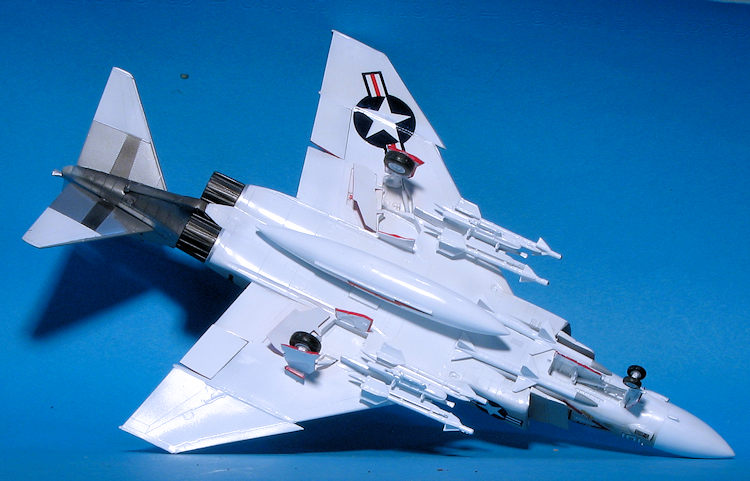 started painting a lot of bits white including the inside of the intakes, gear doors, wheel wells, stabiliators, landing gear, and a number of other bits. When the cockpit tub was done, the consoles were painted black along with the instrument panels and the back of the intake. Installing the USN back panel pieces showed that one of those was missing as well.
started painting a lot of bits white including the inside of the intakes, gear doors, wheel wells, stabiliators, landing gear, and a number of other bits. When the cockpit tub was done, the consoles were painted black along with the instrument panels and the back of the intake. Installing the USN back panel pieces showed that one of those was missing as well.
The cockpit was trapped in the fuselage halves and the seams were dealt with. I also assembled the wings at this time. Fit of the upper and lower halves is not good. Next step was to attach the wings. Thanks to the way the fuselage is molded, one cannot 'squeeze' the fuselage if the wings don't fit. This required some sanding and grinding of the inside of the wings where they attach to the fuselage in order to get a good fit. Once on, the inevitable gap at the leading edge of the wing/fuselage join was done.
With the wings in place, it is a good time to attach the intakes. Conversely, you can attach these prior. It really doesn't make that much difference. Fit of the intakes is about as expected with a kit of this age and design. To me, F-4 intakes are a place where one always gets fit issues of some sort. The usual sanding and filler smoothed things out and wiped out quite a bit of the raised detail.
During all this, I was fussing with things under the wings. I decided not to use the wing fuel tanks so filled those holes. I also assembled the centerline tank and cleaned up the missiles I was going to use. For some reason, Monogram molded some sort of 'thing' on one of the nose vanes of the Sidewinders. Perhaps they 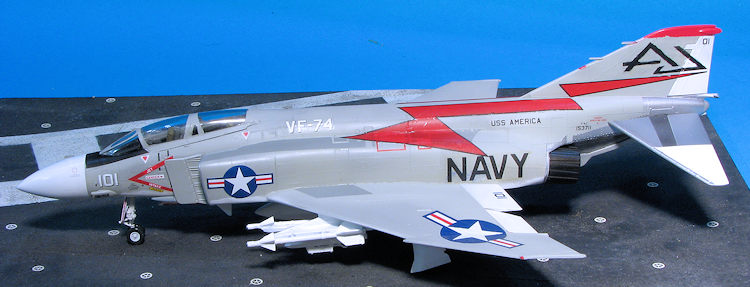 are supposed to be caps and cables, but I've never seen anything quite like them so those were removed. I also assembled the pylons and Sidewinder launch rails. I am not fitting bombs to this one, but couldn't come up with a clean way to remove the TERs so left them. Once that was done, I did a lot of painting with white on not only the weapons, tanks and pylons, but also the gear doors, wheel wells and stabs. It was during this that I realized the kit was also missing the main gear retraction struts.
are supposed to be caps and cables, but I've never seen anything quite like them so those were removed. I also assembled the pylons and Sidewinder launch rails. I am not fitting bombs to this one, but couldn't come up with a clean way to remove the TERs so left them. Once that was done, I did a lot of painting with white on not only the weapons, tanks and pylons, but also the gear doors, wheel wells and stabs. It was during this that I realized the kit was also missing the main gear retraction struts.
The canopy was masked and then installed. I chose the one-piece canopy for this one as the interior wasn't worth showing off with all the missing bits. Fit is fairly good, though there was a step at the back. I used filler to smooth out that particular area.
| COLORS & MARKINGS |
Painting the F-4 is a rather complex situation, even for one that is light gull and grey. It has to do with all the metallic parts on the rear fuselage and stabilizer. What I did for the stabs was paint it white, then masked it and did the metal parts using shades of Alclad II. For the rear fuselage, I first painted the metal parts, then masked those and applied the other colors. I used Superscale sheet 72-823 which had a nice VF-74 plane on it. This plane has a white radome. I found that using 1mm tape for the initial demarcation line works well. The rest can then be filled in with wider tape. The fin tip on this needs to be painted red and the black nose anti-glare panel needs to be painted as well. As a note, the speedbrake interior is red, but the well is not. A lot of F-4 modelers will paint the speedbrake well red, but period photos show this was not generally the case.
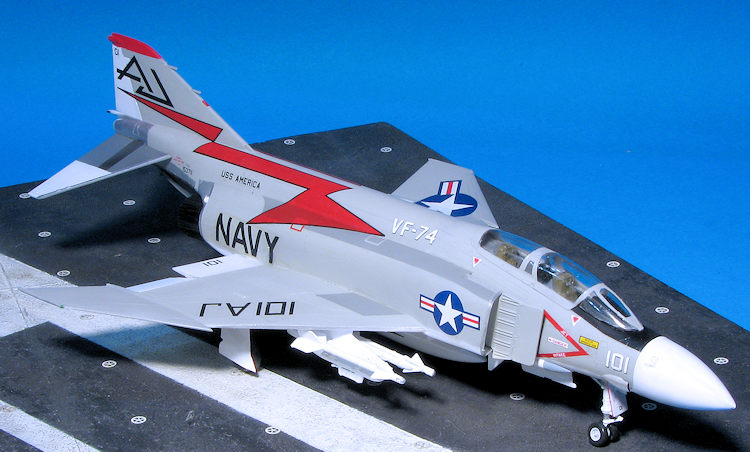 With the major colors in place, I then assembled the landing gear. For the missing retraction struts, I used plastic tubing and wire to replace them. It isn't perfect, but better than nothing. Note that the F-4's main gear is slightly canted inward when on the ground. I then started applying the decals. The sheet states it is designed for the Hasegawa kit and to use the wing and fuselage walkways that come in that kit. The Monogram kit does not include these, but I had an old Microscale sheet that had the dark grey walkway markings I needed, and despite their 30 year age, went on without any issues. I then applied the Superscale markings. I did have issues with the large red fuselage markings in two areas. One is that the red is not backed by white so what is underneath them shows through. You can see that in the photos where it crosses the fuselage walk areas. Secondly, the large fuselage markings tore very easily. One side tore into five segments and the other into two. The NAVY mar
With the major colors in place, I then assembled the landing gear. For the missing retraction struts, I used plastic tubing and wire to replace them. It isn't perfect, but better than nothing. Note that the F-4's main gear is slightly canted inward when on the ground. I then started applying the decals. The sheet states it is designed for the Hasegawa kit and to use the wing and fuselage walkways that come in that kit. The Monogram kit does not include these, but I had an old Microscale sheet that had the dark grey walkway markings I needed, and despite their 30 year age, went on without any issues. I then applied the Superscale markings. I did have issues with the large red fuselage markings in two areas. One is that the red is not backed by white so what is underneath them shows through. You can see that in the photos where it crosses the fuselage walk areas. Secondly, the large fuselage markings tore very easily. One side tore into five segments and the other into two. The NAVY mar king for the fuselage is way oversize. More like something in 1/48 than 1/72 scale. Fortunately, the kit marking is the right size. I think the wing insignia are too large. I also overdid the setting solution and trashed the left side tail marking, causing the ink to run. This has turned into a bit of a disaster kit. I brush painted the melted markings and moved on.
king for the fuselage is way oversize. More like something in 1/48 than 1/72 scale. Fortunately, the kit marking is the right size. I think the wing insignia are too large. I also overdid the setting solution and trashed the left side tail marking, causing the ink to run. This has turned into a bit of a disaster kit. I brush painted the melted markings and moved on.
I should mention that I also trashed the underwing insignia by moving it before it dried. This caused it to fold on itself, making it impossible to repair. I pulled up most of the offending marking and found a replacement in a 1/48 insignia sheet.
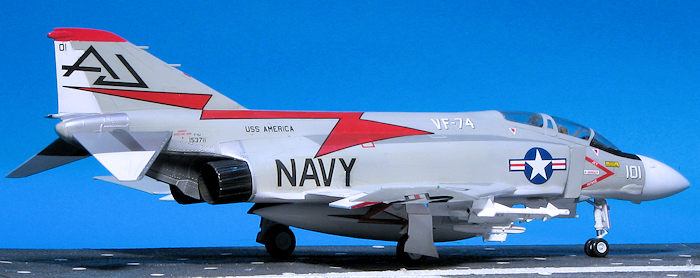 So, the decals were finally in place. Now to attach the rest of the bits. I first glued on the wheels, breaking an axle on one. When that had dried, it was time for the gear doors. The two outer main gear doors have to be cut apart prior to gluing. I used a Sharpie for the red edges. The inner doors have small retraction struts, yet they were no where to be found. Yep, more missing bits from a 'complete' kit. I then glued on the centerline tank, followed by the tailplanes. These interlock, making alignment much easier. The wing pylons had the missiles attached and then glued. I also glued on the forward Sparrows. No missile bands as I was getting pretty fed up with working on this one. The final items to attach were the speed brakes.
So, the decals were finally in place. Now to attach the rest of the bits. I first glued on the wheels, breaking an axle on one. When that had dried, it was time for the gear doors. The two outer main gear doors have to be cut apart prior to gluing. I used a Sharpie for the red edges. The inner doors have small retraction struts, yet they were no where to be found. Yep, more missing bits from a 'complete' kit. I then glued on the centerline tank, followed by the tailplanes. These interlock, making alignment much easier. The wing pylons had the missiles attached and then glued. I also glued on the forward Sparrows. No missile bands as I was getting pretty fed up with working on this one. The final items to attach were the speed brakes.
| CONCLUSIONS |
Well, this one was quite a trial. I do hope that I managed to roll a year's worth of disasters into this one. Some issues with the standard kit are the space between the tailplanes and fuselage, the angle of the main landing gear doors (they should be even with the ground), the 'thingies' on the Sidewinders, and the molded in TERs. The final result somewhat belies all the issues I had, most of them self-induced and not a fault of the folks at Monogram who designed it. It is a 30 year old kit that is based on the 1/48 scale kit that is probably ten years older still. Despite all that, it can be made into a nice model and is worth picking up if you see one on a vendor's table. Just be sure to parts check it!
18 November 2016
Copyright ModelingMadness.com. All rights reserved.
Thanks to me for the review kit. These can be found with a little effort.
If you would like your product reviewed fairly and fairly quickly, please contactthe editor or see other details in the